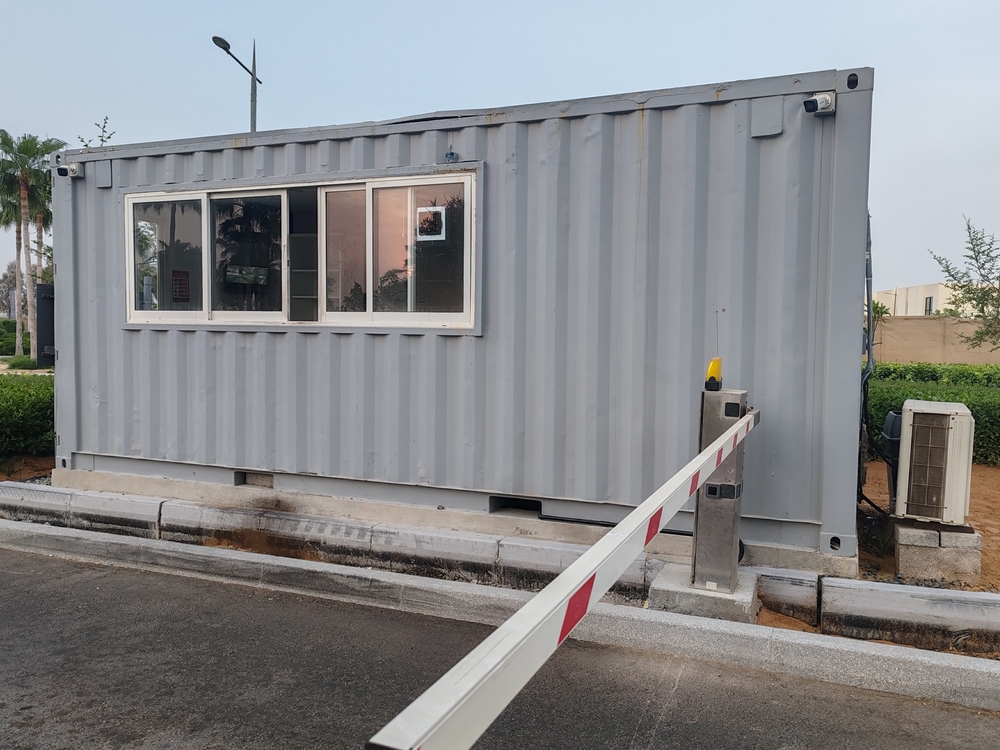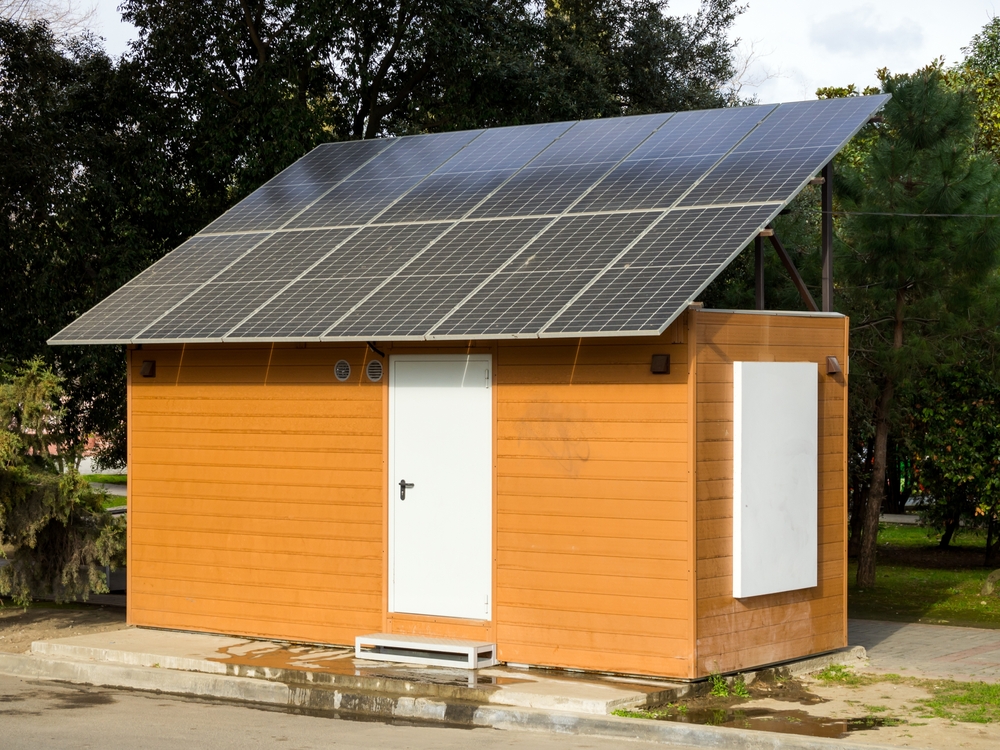Your cart is currently empty!
A Company in Kenya Builds Houses From Recycled Shipping Containers – Solar-Powered and Ready in Days

A shipping container sits in a Nairobi yard on Monday morning. By Thursday evening, a family calls it home, complete with solar power and running water. Across Kenya, steel boxes that once carried cargo across oceans now serve as houses, offices, and shops.
Container conversion represents one response to Kenya’s housing needs. Companies report construction times of four days for basic units, compared to six to twelve months for traditional buildings. Solar panel integration adds energy independence to these structures, addressing both housing and power reliability concerns.
But rapid construction raises questions. How do these structures handle Kenya’s varied climate? What are the real costs? Who chooses container living, and why?
From Cargo Box to Family Home: How Container Conversion Works
Container conversion begins with a structural assessment. Inspection teams check for rust, evaluate corner posts, and examine flooring integrity. Containers meeting standards move to the modification phase. Those failing inspection go to the scrap.
Modification involves cutting openings for doors and windows. Each opening requires reinforcement to maintain structural integrity. Welders add steel frames around cuts. Engineers calculate load distribution for each modification.
Insulation installation addresses climate control. Spray foam fills wall cavities. Reflective barriers line interior surfaces. Vapor barriers prevent moisture accumulation. Different regions require different insulation approaches based on local climate conditions.
Infrastructure systems follow predetermined plans. Electrical wiring runs through conduits. Plumbing connects at specific points. Solar mounting hardware attaches to reinforced sections. Pre-planning reduces installation time significantly.
Inspection protocols verify safety standards. Structural modifications undergo load testing. Electrical systems require certification. Plumbing faces pressure testing. Each phase must pass before proceeding.
Sun Power Meets Steel Walls: Solar Integration That Works

Container roofs provide flat surfaces for solar panel mounting. Steel structures support panel weight without additional reinforcement. Standard installations include 4-8 panels, generating 1-2 kilowatts. Larger systems remain possible with structural evaluation.
Battery storage systems occupy designated spaces within containers. Typical installations use 2-4 lithium batteries, storing 5-10 kilowatt-hours. Smart inverters manage power distribution between solar generation, battery storage, and grid connections where available.
Power generation varies by location and season. Coastal areas average 5 sun hours daily. Highland regions receive 4-6 hours. Rainy seasons reduce generation by 30-40%. Most systems include grid connections or generators for backup.
Installation costs range from 100,000 to 200,000 Kenyan shillings for basic systems. Larger systems cost proportionally more. Maintenance involves panel cleaning and battery monitoring. System lifespans average 20-25 years for panels, 5-10 years for batteries.
Energy production typically covers basic household needs: lighting, phone charging, laptop use, and efficient appliances. High-consumption devices like electric cookers or water heaters may exceed system capacity during cloudy periods.
Four Days to Move-In Ready: Breaking Down the Speed
Day one involves site preparation and container placement. Cranes position containers on prepared foundations. Basic foundation types include concrete blocks or steel posts. Leveling ensures proper drainage and structural stability.
Days two and three focus on interior completion. Wall framing takes 4-6 hours. Insulation installation requires 6-8 hours. Flooring installation needs 3-4 hours. Plumbing rough-in takes 4-5 hours. Electrical rough-in requires 5-6 hours.
Day four covers finishing work. Paint application needs 3-4 hours drying time in typical weather. Fixture installation takes 2-3 hours. System testing requires 2 hours. Final inspection adds 1-2 hours.
Several factors enable rapid construction. Pre-fabricated components arrive ready for installation. Specialized crews work simultaneously on different systems. The weather doesn’t delay interior work. No concrete curing time is needed for the main structure.
Limitations exist within this timeline. Complex designs require additional days. Custom modifications extend schedules. Remote locations face transport delays. Permit approvals can add weeks before construction begins.
Real Costs vs. Traditional Building

Basic 20-foot container conversions cost 600,000 to 1,000,000 Kenyan shillings. Forty-foot containers range from 1,000,000 to 1,500,000. Multi-container configurations multiply costs accordingly. These figures include conversion but exclude land.
Traditional construction for similar square footage costs 1,500,000 to 3,000,000 shillings. Time-related costs add more: extended rent during construction, construction loan interest, and potential material price increases over longer build periods.
Operating costs show mixed results. Solar-powered containers eliminate or reduce electricity bills. However, some insurance companies charge higher premiums for non-traditional structures. Maintenance costs remain under study, as most installations are less than ten years old.
Financing presents challenges. Some banks accept container homes as collateral; others don’t. Interest rates vary by lender and borrower qualifications. Down payment requirements range from 10% to 30%.
Resale values remain uncertain. Limited market data exists for container home sales. Location influences value more than construction type. Buyer perception varies significantly by region and demographic.
Daily Reality of Container Home Life
Standard containers offer 160 square feet (20-foot) or 320 square feet (40-foot). Multi-container designs create larger spaces but increase costs proportionally. Ceiling heights measure 7.5 to 8 feet after insulation installation.
Temperature regulation depends on insulation quality and ventilation design. Well-insulated containers maintain comfortable temperatures in most Kenyan climates. Poor insulation leads to extreme heat or cold. Air conditioning may be necessary in coastal areas despite good insulation.
Sound transmission presents challenges. Metal structures conduct sound readily. Insulation reduces but doesn’t eliminate noise transmission. Rain creates significant noise on metal roofs. Additional soundproofing increases costs.
Storage requires creative solutions. Built-in furniture maximizes space efficiency. Wall-mounted storage reduces floor clutter. External storage sheds often supplement container homes. Some residents report feeling cramped despite organizational efforts.
Daily maintenance includes condensation monitoring, especially during temperature swings. Rust prevention requires regular inspection and treatment. Solar panels need periodic cleaning for optimal performance.
Kenya’s Climate Challenge: How Containers Handle Heat and Rain

Coastal regions test containers with high humidity and salt exposure. Proper ventilation prevents moisture buildup inside. Exterior coatings protect against salt corrosion. Without maintenance, coastal containers show deterioration within 5-7 years.
Highland areas present temperature extremes. Night temperatures can drop below 10°C while day temperatures exceed 25°C. Insulation quality determines comfort levels. Some highland residents report needing supplementary heating during cold seasons.
Rainy seasons reveal waterproofing quality. Properly sealed containers remain dry. Poor sealing leads to leaks, particularly around modifications. Water damage can compromise insulation effectiveness and promote rust.
Urban heat islands affect container temperatures. Metal surfaces absorb and radiate heat. White or reflective coatings reduce heat absorption by 20-30%. Tree shade significantly improves comfort, but isn’t always available.
Green Living Beyond Solar: Environmental Wins
Container conversion represents “recycling on a massive scale” according to industry descriptions. Each container diverts approximately 3,500 kilograms of steel from waste streams. However, modification processes consume energy and materials.
Carbon footprint comparisons show mixed results. Container conversion eliminates new material production emissions. Transport and modification add emissions back. Total emissions depend on transport distance and modification extent.
Water harvesting suits container structures. Roof designs facilitate rainwater collection. Storage tanks integrate with container placement. However, the initial cost increases by 50,000-100,000 shillings for basic systems.
Waste generation during conversion remains significant. Metal cutting produces scraps. Insulation packaging creates waste. Paint and chemical containers require proper disposal. Construction waste, while less than traditional building, isn’t eliminated.
Challenges Nobody Talks About

Space constraints affect families differently. Couples adapt more easily than families with children. Teenagers particularly struggle with privacy needs. Elderly residents may find container layouts challenging for mobility aids.
Social stigma persists in many communities. Some neighbors view containers as temporary or substandard housing. Property values in traditional neighborhoods might be affected. Children sometimes face teasing about living in “boxes.”
Technical expertise shortage limits options. Few contractors understand container conversion properly. Rural areas lack qualified installers entirely. Poor workmanship leads to comfort and safety issues.
Regulatory uncertainty complicates planning. Some counties embrace container construction; others restrict it. Building codes don’t always address container-specific issues. Permit processes vary widely between locations.
Health concerns exist around insulation materials and ventilation. Some spray foam insulations off-gas chemicals. Poor ventilation concentrates indoor air pollutants. Limited research exists on long-term health impacts.
Making Decisions: Practical Considerations
Container homes suit specific situations. Single people and couples adjust more easily than large families. Temporary land arrangements benefit from container mobility. Rural plots without infrastructure become viable. Budget-conscious builders save on initial costs.
Unsuitable situations include areas with strict architectural guidelines, families needing multiple bedrooms, people with chemical sensitivities, and locations with extreme weather conditions.
Site requirements affect feasibility. Access roads must accommodate container trucks and cranes. Soil stability determines foundation needs. Utility connections influence total costs. Zoning regulations may prohibit container structures.
Timeline expectations need adjustment. While construction takes days, preliminary steps take weeks or months. Permit approval varies by location. Container sourcing depends on availability. Site preparation requires separate scheduling.
Container Housing in Kenya: Current Reality and Future Questions

Container homes exist across Kenya today, housing families from Mombasa to Nairobi. Construction companies report steady demand. Government agencies explore container options for rapid housing deployment. Private developers test container-based affordable housing models.
Data remains limited on long-term performance. Most installations date from the last decade. Durability in Kenyan conditions needs more study. Resident satisfaction varies by installation quality and expectations.
Industry claims include “ready for occupation within 4-8 weeks” and possibilities “limited only by imagination.” Reality shows both successes and failures. Quality varies significantly between providers. Buyer research remains essential.
Future developments depend on several factors. Regulatory framework evolution will affect adoption. Technical training expansion could improve quality. Public perception shifts might increase acceptance. Climate change considerations may favor or discourage container use.
Container conversion offers one option among many for Kenya’s housing needs. Solar integration provides energy independence where grid power remains unreliable. Four-day construction addresses urgent housing needs. Yet questions remain about long-term viability, social acceptance, and true environmental impact. As Kenya seeks housing solutions, container homes represent neither a complete answer nor a passing trend, but rather one tool requiring careful consideration of benefits, limitations, and individual circumstances.
